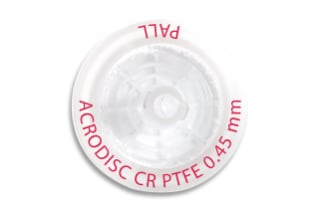
Hydrophobic, polytetrafluoroethene (PTFE) membranes are recommended for use with non-aqueous solvents. Organic-based, highly acidic or basic samples and solvents.
|
UNSPSC |
41104918 |
|
Brand |
Acrodisc |
|
Product Type |
Filtration |
|
Units per Package |
1000 case |
|
Diameter |
25 mm |
|
Format |
Syringe Filter |
|
Hold-up Volume |
< 100 µL |
|
Housing Material |
Polypropylene |
|
Pore Size |
0.45 µm |
|
Sample Volume |
< 100 mL |
|
Separation Mode |
Non polar |
|
Filter Type |
PTFE |
Acrodisc, Syringe Filter, PTFE, 25 mm, 0.45 µm, Non polar, 1000/case
Use the Acrodisc, Syringe Filter, PTFE for the extraction and filtration of aggressive solvents and organics. The lab equipment offers high-quality filtration for analytical samples and is certified for HPLC to ensure low extractables.
Its housing material is hydrophobic polytetrafluoroethylene membrane on a polypropylene support which makes it ideally suited for filtration of gas and/or organic solvents. It also prevents "air bubble" lock when filling sample vials with a 13 mm mini spike outlet.
You can depend on the Acrodisc, Syringe Filter, PTFE to work with HPLC as it has been tested for compatibility with common HPLC solvents using established HPLC procedures. To ascertain this, low levels of UV-detectable extractables, representative samples are tested using a highly sensitive HPLC technique.
It is critical to note that this product is not approved for use in medical, clinical, surgical, or other patient applications. However, if you are exploring avenues in life science, pharmaceutical methods, research and development, quality control, or especialty environmental applications, you can depend on the Acrodisc, Syringe Filter, PTFE to be the lab equipment that offers unfailing quality.
The exceptional separation technology used in the manufacturing of Acrodisc, Syringe Filter, PTFE makes sure you get accurate pore size ratings for better chromatography, and instrument and column protection. It also offers uniform membrane materials (lot-to-lot) for consistent analytical results and low extractable materials for less chromatographic interference. In addition to this, the materials of construction have been designed and selected specially for analytical analysis with lower extractables and lower API adsorption.
If you are interested in more products like the one listed here and want to explore further variations or to shop for lab equipment, look through our catalog. Our website has extensive material regarding the technologies used in the manufacturing and development of products for better understanding as well.
You may also be interested in Acrodisc, Syringe Filter, PVDF, 13 mm, 0.45 µm, Protein, 100/pk which works well with both aqueous and organic solvents.
How Do I Perform Filtration?
Before filling the syringe with a sample, draw approximately 1 mL of air into the syringe. This technique ensures that the air will accompany the sample out of the syringe, effectively carrying it through. Termed as an "air purge," this process minimizes fluid retention within the filter device. Subsequently, proceed to fill the syringe with the solution intended for filtration. With one hand holding the filter device, securely attach the filled syringe to the device using a twisting motion, ensuring not to apply excessive force. Initiate the filtration process by gently applying pressure.